
The Staten Island Railway (SIR) is a rapid transit line in the New York City borough of Staten Island. It is owned by the Staten Island Rapid Transit Operating Authority (SIRTOA), a subsidiary of the Metropolitan Transportation Authority, and operated by the New York City Transit Authority Department of Subways. SIR operates 24 hours a day, seven days a week, providing local service between St. George and Tottenville, along the east side of the island. There is currently only one line on the island, and there is no direct rail link between the SIR and the New York City Subway system, but SIR riders do receive a free transfer to New York City Transit bus and subway lines, and the line is included on official New York City Subway maps. Commuters on the railway typically use the Staten Island Ferry to reach Manhattan. The line is accessible from within the Ferry Terminal, and most of its trains are timed to connect with the ferry. In 2023, the system had a ridership of 6,151,400, or about 19,500 per weekday as of the fourth quarter of 2023.

The 3 Seventh Avenue Express is a rapid transit service in the A Division of the New York City Subway. Its route emblem, or "bullet", is colored red since it uses the IRT Broadway–Seventh Avenue Line through most of Manhattan.

The Bowling Green station is a station on the IRT Lexington Avenue Line of the New York City Subway, located at Broadway and Battery Place, in the Financial District of Manhattan. It is served by the 4 train at all times and the 5 train at all times except late nights.
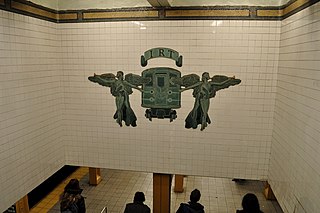
The Grand Army Plaza station is a local station on the IRT Eastern Parkway Line of the New York City Subway. It is located in Park Slope, Brooklyn, underneath Flatbush Avenue at its intersection with Plaza Street West and St. Johns Place, on the northwest side of Grand Army Plaza. It is served by the 2 train at all times, the 3 train at all times except late nights, and the 4 train during late nights.
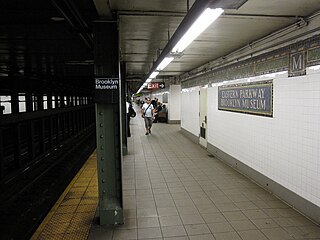
The Eastern Parkway–Brooklyn Museum station is a local station on the IRT Eastern Parkway Line of the New York City Subway. Located at the intersection of Washington Avenue and Eastern Parkway in Brooklyn adjacent to the Brooklyn Museum, it is served by the 2 train at all times, the 3 train at all times except late nights, and the 4 train during late nights.
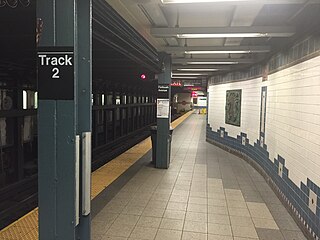
The Flatbush Avenue–Brooklyn College station is the southern terminal station on the IRT Nostrand Avenue Line of the New York City Subway. It is located at the intersection of Flatbush and Nostrand Avenues in Flatbush, Brooklyn, locally called "The Junction". The station is served by the 2 train at all times and the 5 train on weekdays. It is also the closest subway station to Brooklyn College and Midwood High School.
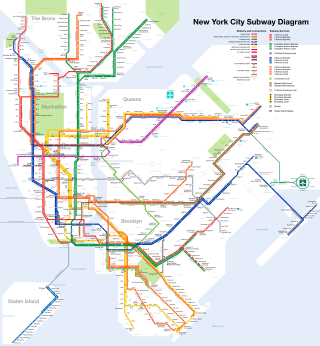
The New York City Subway is a rapid transit system that serves four of the five boroughs of New York City, New York: the Bronx, Brooklyn, Manhattan, and Queens. Its operator is the New York City Transit Authority, which is itself controlled by the Metropolitan Transportation Authority of New York. In 2015, an average of 5.65 million passengers used the system daily, making it the busiest rapid transit system in the United States and the 11th busiest in the world.

The Brighton Beach station is an elevated express and terminal station on the BMT Brighton Line of the New York City Subway. It is located over Brighton Beach Avenue between Brighton 5th Street and Brighton 7th Street in Brighton Beach, Brooklyn. The station is served by the Q train at all times and is the southern terminal for the B train on weekdays only.
The IRT Broadway–Seventh Avenue Line is a New York City Subway line. It is one of several lines that serves the A Division, stretching from South Ferry in Lower Manhattan north to Van Cortlandt Park–242nd Street in Riverdale, Bronx. The Brooklyn Branch, known as the Wall and William Streets Branch during construction, from the main line at Chambers Street southeast through the Clark Street Tunnel to Borough Hall in Downtown Brooklyn, is also part of the Broadway–Seventh Avenue Line. The IRT Broadway–Seventh Avenue Line is the only line to have elevated stations in Manhattan, with two short stretches of elevated track at 125th Street and between Dyckman and 225th Streets.
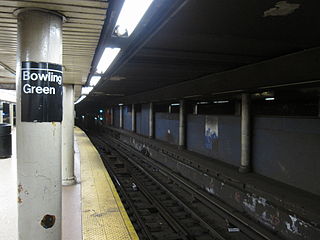
The Bowling Green–South Ferry shuttle was a shuttle service of the New York City Subway system that operated between Bowling Green and the inner loop platform at South Ferry. It operated to provide South Ferry service for IRT Lexington Avenue Line riders during hours when the 5 service did not stop at South Ferry. Because the inner loop station that the shuttle used at the South Ferry station was on such a tight curve, there was no continuous platform; instead four openings in the tunnel wall led into the station. Four R12 cars that were used on the shuttle, 5703–5706, which were modified and equipped so that only the center door of each car would open at one of the open spaces.
Jack Pierson is a photographer and an artist. Pierson is known for his photographs, collages, word sculptures, installations, drawings and artists books. His "Self-Portrait" series was shown in the 2004 Whitney Biennial. His works are held in numerous museum collections.

The South Ferry/Whitehall Street station is a New York City Subway station complex in the Financial District neighborhood of Manhattan, under Battery Park. The complex is shared by the IRT Broadway–Seventh Avenue Line and the BMT Broadway Line. It is served by the 1 and R trains at all times, the W train only on weekdays during the day, and the N train at night.
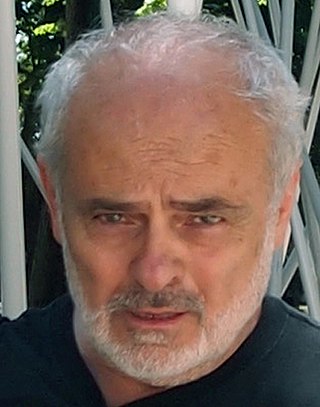
Joshua Neustein is a contemporary visual artist who lives and works in New York City. He is known for his Conceptual Art, environmental installations, Land Art, Postminimalist torn paper works, epistemic abstraction, deconstructed canvas works, and large-scale map paintings.
Ming Fay is a Shanghai-born and New York City-based sculptor and professor. His work focuses on the concept of the garden as a symbol of utopia and the relationship between man and nature. Drawing upon an extensive knowledge of plants both Eastern and Western, real and mythical, Fay creates his own calligraphic floating forest of reeds, branches and surreal species. He is most well known for his sculpture and large scale installations and he currently teaches sculpture at William Paterson University in Wayne, New Jersey.
Jean Shin is an American artist living in Brooklyn, NY. She is known for creating elaborate sculptures and site-specific installations using accumulated cast-off materials.

Tanya Preminger, is an artist working in various media: environmental art, site-specific art, ephemeral art, sculpture, installation and photography. She is mostly known for her land art projects and large-scale stone sculptures.

Big Bambú is a work of installation art by identical twin artists Doug and Mike Starn. Variations on the Big Bambu theme have been constructed at several locations around the world. Combining architecture and sculpture, it examines the tension between chaos and order in nature.
MTA Arts & Design, formerly known as Metropolitan Transportation Authority Arts for Transit and Arts for Transit and Urban Design, is a commissioned art program directed by the Metropolitan Transportation Authority for the transportation systems serving New York City and the surrounding region. Since 1985, the program has installed art in more than 260 transit stations. The art is intended to be site-specific and to improve the journey for New Yorkers and visitors alike.

The Met Fifth Avenue is the primary museum building for the Metropolitan Museum of Art in New York City. The building is located at 1000 Fifth Avenue, along the Museum Mile on the eastern edge of Central Park in Manhattan's Upper East Side.
Rico Gatson is a multidisciplinary artist working in Brooklyn, New York, whose work draws from his African-American background. Through his art, he provides social commentary on significant moments in African-American history. His work combines abstract patterns with vibrant colors, which creates confrontational work that references African American culture and history.














